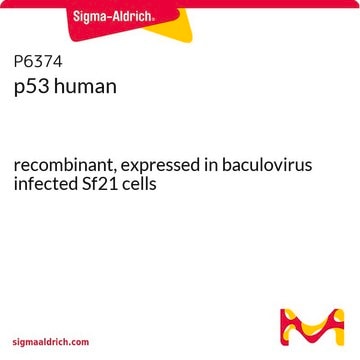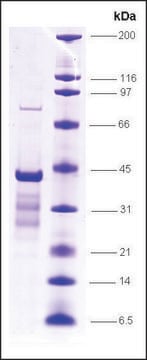SRP2108
p53 (1-81), mutant, GST tagged human
recombinant, expressed in E. coli, ≥80% (SDS-PAGE)
Sinonimo/i:
FLJ92943, LFS1, P53, TRP53
Autenticatiper visualizzare i prezzi riservati alla tua organizzazione & contrattuali
About This Item
Codice UNSPSC:
12352200
NACRES:
NA.26
Prodotti consigliati
Origine biologica
human
Ricombinante
expressed in E. coli
Saggio
≥80% (SDS-PAGE)
Forma fisica
frozen liquid
PM
~34.5 kDa
Confezionamento
pkg of 10 μg
Concentrazione
450 μg/mL
Colore
clear colorless
N° accesso NCBI
N° accesso UniProt
Condizioni di spedizione
dry ice
Temperatura di conservazione
−70°C
Informazioni sul gene
human ... TP53(7157)
Descrizione generale
p53 is a tumor suppressor gene expressed in a wide variety of tissues. It is a tetrameric nuclear DNA-binding phosphoprotein. The gene encoding it is localized on human chromosome 17p13.1.
Azioni biochim/fisiol
The protein has the capability to induce cell cycle arrest and has a role in DNA repair, senescence and apoptosis. It binds to Simian vacuolating virus 40 (SV40) T-antigen and human papilloma virus E6 protein.
p53 was identified as a tumor suppressor by showing that this protein has the ability to block transformation and to inhibit tumor cell growth. In addition, p53 is a transcription factor capable of regulating the expression of a subset of downstream genes. Mutation of two specific N-terminal residues in p53 (residues Leu22 and Trp23) impairs the ability of p53 to transactivate and has been correlated with its ability to bind TAFII40 and TAFII60 (or TAFII31 and TAFII70) (7, 8) suggesting that one or both of these interactions is important for activation. Mutation of residues 22 and 23 to Ala does not affect binding to TBP, although mutation of these residues to charged amino acids has been reported to disrupt the p53-TBP interaction. Different mutations in p53 gene have been characterized in a variety of human cancers. Loss or mutation of p53 function is highly correlated with tumorigenesis.
Stato fisico
Clear and colorless frozen liquid solution
Nota sulla preparazione
Use a manual defrost freezer and avoid repeated freeze-thaw cycles. While working, please keep sample on ice.
Codice della classe di stoccaggio
10 - Combustible liquids
Classe di pericolosità dell'acqua (WGK)
WGK 1
Punto d’infiammabilità (°F)
Not applicable
Punto d’infiammabilità (°C)
Not applicable
Certificati d'analisi (COA)
Cerca il Certificati d'analisi (COA) digitando il numero di lotto/batch corrispondente. I numeri di lotto o di batch sono stampati sull'etichetta dei prodotti dopo la parola ‘Lotto’ o ‘Batch’.
Possiedi già questo prodotto?
I documenti relativi ai prodotti acquistati recentemente sono disponibili nell’Archivio dei documenti.
Cooper GM.
The Cell: A Molecular Approach null
D Michalovitz et al.
Cell, 62(4), 671-680 (1990-08-24)
Mutant p53 can contribute to transformation, while wild-type (wt) p53 is not oncogenic and actually inhibits transformation. Furthermore, wt p53 may act as a suppressor gene in human carcinogenesis. We now describe the temperature-sensitive behavior of a particular mutant, p53val135.
C A Finlay et al.
Cell, 57(7), 1083-1093 (1989-06-30)
DNA clones of the wild-type p53 proto-oncogene inhibit the ability of E1A plus ras or mutant p53 plus ras-activated oncogenes to transform primary rat embryo fibroblasts. The rare clones of transformed foci that result from E1A plus ras plus wild-type
S J Baker et al.
Science (New York, N.Y.), 249(4971), 912-915 (1990-08-24)
Mutations of the p53 gene occur commonly in colorectal carcinomas and the wild-type p53 allele is often concomitantly deleted. These findings suggest that the wild-type gene may act as a suppressor of colorectal carcinoma cell growth. To test this hypothesis
Mutations in the p53 Tumor Suppressor Gene
Noa Rivlin
Genes & Cancer, 2(4), 466-474 (2011)
Il team dei nostri ricercatori vanta grande esperienza in tutte le aree della ricerca quali Life Science, scienza dei materiali, sintesi chimica, cromatografia, discipline analitiche, ecc..
Contatta l'Assistenza Tecnica.








